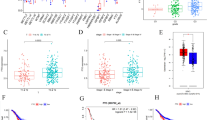Abstract
Hydroxymethylglutaryl coenzyme A reductase (HMGCR), the rate-limiting enzyme of mevalonate pathway, has been involved in the tumorigenesis of several tumor types. Our previous study has showed that statin, the inhibitor of HMGCR, inhibited the tumorigenecity of esophageal squamous cell carcinoma (ESCC) in vitro and in vivo. However, the function of HMGCR in the carcinogenesis of ESCC cells remains unknown. In this study, we have observed the up-regulation of HMGCR in ESCC tissues compared with the paired normal tissues. Over-expression of HMGCR in ESCC cells promoted cell growth and migration, while knockdown of the expression of HMGCR inhibited the growth, migration and colony formation of ESCC cells in vitro and in vivo. Furthermore, we found that oncogene Myc positively regulated the expression of HMGCR. Taken together, our study revealed the pivotal function of HMGCR and mevalonate pathway in the progression of ESCC and supported the clinical application of statin.





Similar content being viewed by others
References
Toh Y, Oki E, Ohgaki K, et al. Alcohol drinking, cigarette smoking, and the development of squamous cell carcinoma of the esophagus: molecular mechanisms of carcinogenesis. Int J Clin Oncol. 2010;15:135–44.
Zhou ZQ, Cao WH, Xie JJ, et al. Expression and prognostic significance of THBS1, Cyr61 and CTGF in esophageal squamous cell carcinoma. BMC Cancer. 2009;9:291–7.
Zhu YH, Fu L, Chen LL, et al. Downregulation of the novel tumor suppressor DIRAS1 predicts poor prognosis in esophageal squamous cell carcinoma. Cancer Res. 2013;73(7):2298–309.
Wang XJ, Zheng YL, Fan QX, et al. RNAi-induced K-Ras gene silencing suppresses growth of EC9706 cells and enhances chemotherapy sensitivity of esophageal cancer. APJCP. 2012;13(12):6517–21.
Deberardinis RJ, Lum JJ, Hatzivassiliou G, Thompson CB. The biology of cancer: metabolic reprogramming fuels cell growth and proliferation. Cell Metab. 2008;7:11–20.
Bassam AR, Ian N, Ka FL, et al. A novel statin-mediated “prenylation block-and-release” assay provides insight into the membrane targeting mechanisms of small GTPases. BBRC. 2010;397:34–41.
Davidson MH. Safety profiles for the HMG CoA reductase inhibitors: treatment and trust. Drugs. 2001;61:197–206.
Cauley JA. Statin use and breast cancer: prospective results from the Women’s Health Initiative. J Natl Cancer Inst. 2006;98:700–7.
Shimano H. Sterol regulatory element-binding proteins (SREBPs): transcriptional regulators of lipid synthetic genes. Prog Lipid Res. 2001;40:439–52.
Brown MS, Goldstein JL. The SREBP pathway: regulation of cholesterol metabolism by proteolysis of a membrane-bound transcription factor. Cell. 1997;89:331–40.
Hua X, Wu J, Goldstein JL, Brown MS, Hobbs HH. Structure of the human gene encoding sterol regulatory element binding protein-1 (SREBF1) and localization of SREBF1 and SREBF2 to chromosomes 17p11.2 and 22q13. Genomics. 1995;25:667–73.
Shimano H, Shimomura I, Hammer RE, et al. Elevated levels of SREBP-2 and cholesterol synthesis in livers of mice homozygous for a targeted disruption of the SREBP-1 gene. J Clin Invest. 1997;100:2115–24.
Shi J, Zhu J, Zhao H, Zhong C, Xu Z, Yao F. Mevalonate pathway is a therapeutic target in esophageal squamous cell carcinoma. Tumour Biol. 2012;34(1):429–35.
Menendez JA, Lupu R. Fatty acid synthase and the lipogenic phenotype in cancer pathogenesis. Nat Rev Cancer. 2007;7:763–77.
Yamashita T, Honda M, Takatori H, Nishino R, Minato H, et al. Activation of lipogenic pathway correlates with cell proliferation and poor prognosis in hepatocellular carcinoma. J Hepatol. 2009;50:100–10.
Goldstein JL, Brown MS. Regulation of the mevalonate pathway. Nature. 1990;343:425–30.
Jackson SM, Ericsson J, Edwards PA. Signaling molecules derived from the cholesterol biosynthetic pathway. Subcell Biochem. 1997;28:1–21.
Cao ZW, Hua FM, David I, et al. Myc phosphorylation, activation and tumorigenic potential in hepatocellular carcinoma are regulated by HMG-CoA reductase. Cancer Research. 2011;71:2286–97.
Acknowledgement
This work was supported by the Natural Science Foundation of Shanghai grants 13ZR1461300.
Conflicts of interest
None
Author information
Authors and Affiliations
Corresponding authors
Additional information
C. Zhong and L. Fan contributed equally to this work.
Rights and permissions
About this article
Cite this article
Zhong, C., Fan, L., Yao, F. et al. HMGCR is necessary for the tumorigenecity of esophageal squamous cell carcinoma and is regulated by Myc. Tumor Biol. 35, 4123–4129 (2014). https://doi.org/10.1007/s13277-013-1539-8
Received:
Accepted:
Published:
Issue Date:
DOI: https://doi.org/10.1007/s13277-013-1539-8




